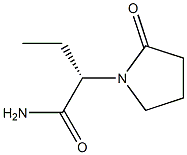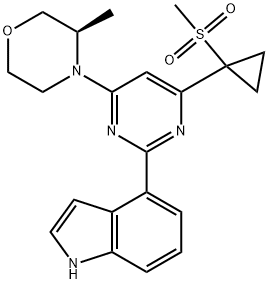DO264
- CAS NO.:2301866-59-9
- Empirical Formula: C23H20Cl2F3N5O2S
- Molecular Weight: 558.4
- MDL number: MFCD31812603
- EINECS: 604-604-1
- Update Date: 2024-11-19 23:02:33

What is DO264?
Description
DO264 is an inhibitor of α/β-hydrolase domain-containing protein 12 (ABHD12; IC50 = 11 nM). It inhibits ABHD12-dependent hydrolysis of lysophosphatidylserine (lyso-PS) in mouse brain membrane lysates (IC50 = 2.8 nM) and human THP-1 cells. DO264 increases levels of chemokine (C-C motif) ligand 3 (CCL3), CCL4, TNF-α, and IL-1β in M1-polarized THP-1 macrophages. It potentiates ferroptotic cell death induced by the glutathione peroxidase 4 (GPX4) inhibitor RSL3 in HT1080 fibrosarcoma and SU-DHL-5 B cell lymphoma cells when used at a concentration of 1 μM. In vivo, DO264 (30 mg/kg per day for four weeks) increases levels of 1-stearoyl-2-hydroxy-sn-glycero-3-PS, 1-arachidonoyl-2-hydroxy-sn-glycero-3-PS, 1-docosanoyl-2-hydroxy-sn-glycero-3-PS, 1-stearoyl-2-arachidonoyl-sn-glycero-3-PS, and 1-oleoyl-2-arachidonoyl-sn-glycero-3-PS in mouse brain. It increases levels of CCL2, CCL3, and CCL5 in bronchoalveolar lavage fluid (BALF) and decreases survival in a mouse model of infection with lymphocytic choriomeningitis virus (LCMV) clone 13 when administered at a dose of 30 mg/kg.
The Uses of DO264
DO264 is a potent inhibitor of ABHD12 (α/β-hydrolase domain-containing 12) which shows negligible interaction with other serine hydrolases as determined by activity-based protein profiling.
References
1) Ogasawara?et al.?(2019),?Discovery and Optimization of Selective and in Vivo Active Inhibitors of the Lysophosphatidylserine Lipase α/β-Hydrolase Domain-Containing 12 (ABHD12); J. Med. Chem.,?62?1643 2) Ogasawara?et al.?(2018),?Selective Blockade of the Lyso-PS Lipase ABHD12 Stimulates Immune Responses In Vivo; Nat. Chem. Biol.,?14?1099
Properties of DO264
| Boiling point: | 601.5±65.0 °C(Predicted) |
| Density | 1.52±0.1 g/cm3(Predicted) |
| storage temp. | under inert gas (nitrogen or Argon) at 2–8 °C |
| solubility | Soluble in DMSO (up to 30 mg/ml). |
| form | solid |
| pka | 11.53±0.70(Predicted) |
| color | Pale yellow |
| Stability: | Stable for 1 year from date of purchase as supplied. Solutions in DMSO may be stored at -20° for up to 1 month. |
Safety information for DO264
| Signal word | Warning |
| Pictogram(s) |
 Exclamation Mark Irritant GHS07 |
| GHS Hazard Statements |
H302:Acute toxicity,oral H315:Skin corrosion/irritation H319:Serious eye damage/eye irritation H335:Specific target organ toxicity, single exposure;Respiratory tract irritation |
| Precautionary Statement Codes |
P261:Avoid breathing dust/fume/gas/mist/vapours/spray. P305+P351+P338:IF IN EYES: Rinse cautiously with water for several minutes. Remove contact lenses, if present and easy to do. Continuerinsing. |
Computed Descriptors for DO264
New Products
4-AMINO-TETRAHYDRO-PYRAN-4-CARBOXYLIC ACID HCL 4-(Dimethylamino)tetrahydro-2H-pyran-4-carbonitrile 4-Aminotetrahydropyran-4-carbonitrile Hydrochloride (R)-3-Aminobutanenitrile Hydrochloride 3-((Dimethylamino)methyl)-5-methylhexan-2-one oxalate 1,4-Dioxa-8-azaspiro[4.5]decane 5-Bromo-2-nitropyridine Nimesulide BP Aceclofenac IP/BP/EP Diclofenac Sodium IP/BP/EP/USP Mefenamic Acid IP/BP/EP/USP Ornidazole IP Diclofenac Potassium THOMAIND PAPER PH 2.0 TO 4.5 1 BOX BUFFER CAPSULE PH 9.2 - 10 CAP SODIUM CHLORIDE 0.1N CVS ALLOXAN MONOHYDRATE 98% PLATINUM 0.5% ON 3 MM ALUMINA PELLETS (TYPE 73) LITHIUM AAS SOLUTION 2-Bromo-1-(bromomethyl)-3-chloro-5-nitrobenzene 2-Bromo-3-nitroaniline N-(3-Hydroxypropyl)-N-methylacetamide 3-Bromo-6-chloropyridazine 4-ethyl-3-nitrobenzoic acidRelated products of tetrahydrofuran
![N-(3-Chlorophenyl)-N'-[5-[2-(thieno[3,2-d]pyrimidin-4-ylamino)ethyl]-2-thiazolyl]urea methanesulfonate (1:1)](https://img.chemicalbook.in/CAS/20180906/GIF/1146618-41-8.gif)



You may like
-
 1-Methyl-6-oxo-1,6-dihydropyridazine-3-carbonitrile 98%View Details
1-Methyl-6-oxo-1,6-dihydropyridazine-3-carbonitrile 98%View Details
99903-60-3 -
 88491-46-7 98%View Details
88491-46-7 98%View Details
88491-46-7 -
 1823368-42-8 98%View Details
1823368-42-8 98%View Details
1823368-42-8 -
 2-(3-(tert-butyl)phenoxy)-2-methylpropanoic acid 1307449-08-6 98%View Details
2-(3-(tert-butyl)phenoxy)-2-methylpropanoic acid 1307449-08-6 98%View Details
1307449-08-6 -
 Ethyl 3-(furan-2-yl)-3-hydroxypropanoate 25408-95-1 98%View Details
Ethyl 3-(furan-2-yl)-3-hydroxypropanoate 25408-95-1 98%View Details
25408-95-1 -
 2-Chloro-5-fluoro-1-methoxy-3-methylbenzene 98%View Details
2-Chloro-5-fluoro-1-methoxy-3-methylbenzene 98%View Details
1805639-70-6 -
 1784294-80-9 98%View Details
1784294-80-9 98%View Details
1784294-80-9 -
 Lithium ClavulanateView Details
Lithium ClavulanateView Details
61177-44-4